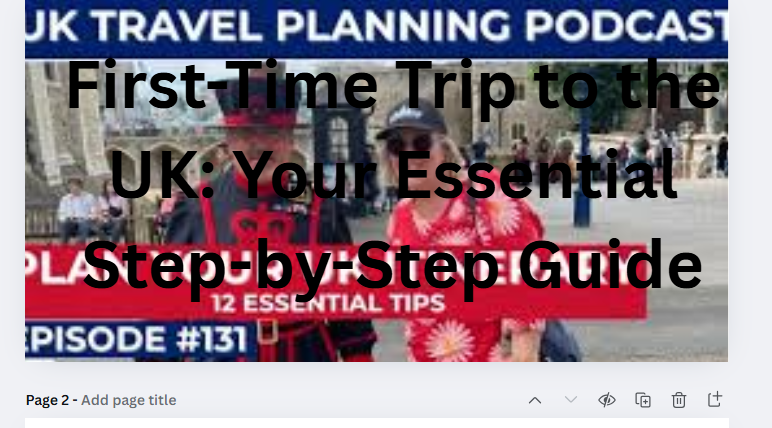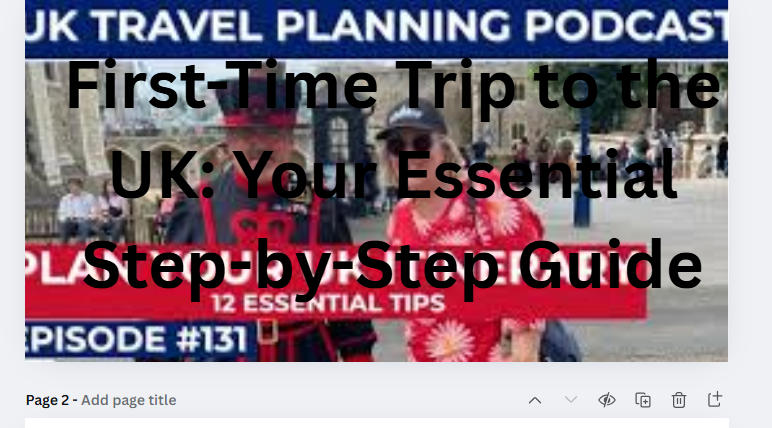
Planning your first trip to the United Kingdom can feel both exciting and overwhelming. From historic landmarks to charming countryside villages, the UK offers an incredible variety of experiences. But where do you start? How do you make sure you don’t miss the essentials while avoiding common tourist mistakes?
This guide walks you through the entire process, from initial planning to returning home, ensuring your first UK adventure is smooth, memorable, and truly British.
Start with the Basics: Documents and Timing
Before you dream about double-decker buses and afternoon tea, let’s handle the practicalities. Getting your documents in order is the first and most crucial step.
Check your passport validity. Most travelers need a passport valid for at least six months beyond their planned departure date from the UK. Depending on your nationality, you may also need a visa. Citizens of the US, Canada, Australia, and the EU can generally visit for up to six months without a visa for tourism, but always verify the latest requirements on the official UK government website.
Next, consider travel insurance. It’s not the most glamorous part of planning, but it’s essential. A good policy covers medical emergencies, trip cancellations, and lost luggage. The NHS (National Health Service) is not free for tourists, so insurance is a must.
When to go? The UK’s weather is famously unpredictable. Summer (June-August) offers the warmest weather and longest days but also the biggest crowds and highest prices. Spring (April-May) and Autumn (September-October) are fantastic alternatives with milder weather and fewer tourists. If you dream of a festive experience, winter can be magical with Christmas markets and decorations, but daylight hours are very short.
Crafting Your Ideal UK Itinerary
Trying to see everything in one trip is the biggest mistake first-timers make. The UK may look small on a map, but it’s packed with sights. Focus on quality over quantity.
A great first-timer’s itinerary might look like this:
- London (4-5 days): This is usually your entry point. You’ll need at least four days to scratch the surface. Must-sees include the British Museum, the Tower of London, Westminster Abbey, and a show in the West End. Don’t forget to simply wander through neighborhoods like Covent Garden and South Bank.
- A Historic University City (2 days): Take a train to Oxford or Cambridge for a day trip or overnight stay. Punting on the river and exploring the ancient college courtyards is a quintessential English experience.
- The English Countryside (2-3 days): Choose one region to explore. The Cotswolds, with its storybook villages of honey-colored stone, is easily accessible from London. Alternatively, head north to the Lake District for stunning landscapes that inspired poets.
- Edinburgh, Scotland (2-3 days): A short flight or a 4.5-hour train ride from London takes you to another capital city. Edinburgh is dramatically different, dominated by its medieval castle and volcanic crag. This gives you a wonderful taste of a different UK culture.
This sample two-week plan balances iconic cities with a glimpse of the countryside. If you have less time, it’s better to deeply explore London and one other region than to rush through five cities.
Smart Booking: Flights, Accommodation, and Transport
Book your flights several months in advance for the best prices. Airports like Heathrow (LHR) and Gatwick (LGW) are well-connected to central London via the Underground (Tube) and express trains.
For accommodation, location is key. In London, staying near a Tube station is more important than having the most luxurious room. Consider neighborhoods like Kensington, Paddington, or Southwark for good transport links. Booking.com and Airbnb are popular, but also check hotel websites directly for special offers.
Getting around the UK is surprisingly easy. For cities, nothing beats walking and using public transport. In London, get an Oyster card or simply use your contactless credit/debit card for the Tube and buses—it automatically calculates the best daily fare.
For travel between cities, trains are efficient and comfortable. Book train tickets in advance on sites like Trainline for significant savings. If you’re planning to explore rural areas, renting a car might be necessary, but you do not want a car in London.
Your UK Packing List: Practicality Over Fashion
The golden rule for packing for the UK: layers and a waterproof jacket. The weather can change from sunny to rainy in minutes.
Comfortable walking shoes are non-negotiable. You will walk much more than you expect. Pack a mix of t-shirts, long-sleeved tops, and a warm sweater. Even in summer, a light jacket is essential.
Don’t forget these often-overlooked items:
- A universal power adapter (the UK uses Type G plugs with three rectangular pins)
- A reusable water bottle
- A small umbrella
- A portable power bank for your phone
Navigating Like a Pro: Money, Etiquette, and Food
Let’s talk about daily life. The currency is the British Pound (£). While credit cards are widely accepted, it’s wise to have some cash for small purchases, market stalls, and tips. Tipping is appreciated but not as expected as in the US. In restaurants, a 10-12% tip is standard if service isn’t included.
British etiquette is generally reserved but polite. Remember to say “please” and “thank you,” and practice the fine art of queuing (waiting in line)—jumping the queue is a major social faux pas.
When it comes to food, go beyond the stereotypes. Yes, try fish and chips from a proper chippy, and enjoy a full English breakfast. But also explore the vibrant food markets like Borough Market in London, and don’t be afraid to try cuisine from the UK’s many excellent Indian restaurants. And of course, make time for a proper afternoon tea—it’s a delightful experience.
Final Checklist Before You Go
A week before your trip, do a final check. Inform your bank you’ll be traveling to avoid your cards being blocked. Download essential apps like Google Maps (for offline use), Trainline, and the local Tube map app. Make sure you have digital and physical copies of your important documents: passport, insurance, and booking confirmations.
Finally, adopt a flexible mindset. Delays can happen, and rain might alter your plans. Some of the best travel memories come from unplanned moments—discovering a cozy pub, striking up a conversation with a local, or simply enjoying a quiet moment in a beautiful park.
Frequently Asked Questions (FAQs)
What’s the best way to get from Heathrow Airport to central London?
The Elizabeth Line (Tube) is now the best balance of speed and cost, taking about 30 minutes to central London. The Heathrow Express is fastest (15 minutes) but more expensive. For budget travelers, the National Express bus is cheapest but takes longer.
Do I need to tip in restaurants?
Service charge (12.5%) is often added to bills in restaurants. If it’s included, no additional tip is needed. If not, leaving 10-12% is appreciated. For pub drinks and taxis, rounding up to the nearest pound is fine, but not expected.
Is the London Pass worth buying?
It depends on your itinerary. If you plan to visit 2-3 attractions per day, it can save money. Calculate the individual entry fees for your planned sights first. Remember, it can feel restrictive trying to “get your money’s worth.”
